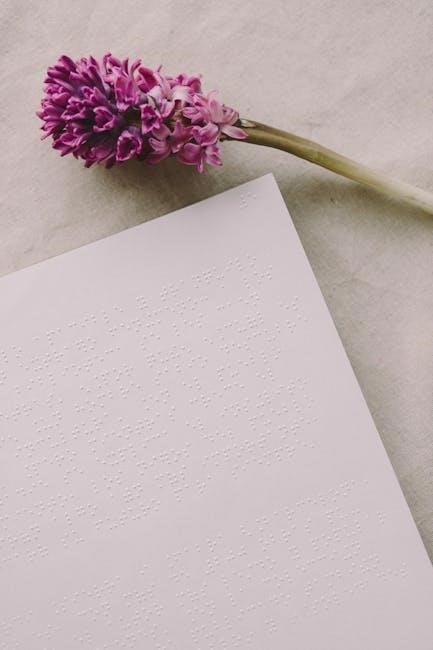moca blind pdf
- by antonina

Overview of the Montreal Cognitive Assessment (MoCA)
The Montreal Cognitive Assessment (MoCA) is a rapid screening tool․ It is designed to detect mild cognitive dysfunction․ The MoCA assesses various cognitive domains, yielding a total score possible of 30 points․
What is the MoCA-Blind?
The MoCA-Blind is an adaptation of the standard MoCA․ This version removes visually-dependent elements․ It allows for cognitive screening in individuals with visual impairments․ The MoCA-Blind has a maximum possible score of 22․
Purpose and Adaptation for Visually Impaired Individuals
The primary purpose of the MoCA-Blind is to provide a cognitive screening tool accessible to individuals with visual impairments․ The standard MoCA relies heavily on visual elements, making it unsuitable for this population․ The MoCA-Blind adapts the original test by removing or modifying items that require sight․ This ensures that the assessment accurately reflects cognitive function rather than visual ability․
Adaptations include replacing visual tasks with auditory or verbal equivalents․ For instance, visuospatial tasks are substituted with tasks assessing auditory attention or verbal fluency․ The MoCA-Blind retains the core cognitive domains assessed by the original MoCA, including memory, language, executive function, and attention․ By adapting the test, clinicians can effectively screen for mild cognitive impairment (MCI) and other cognitive disorders in visually impaired individuals․ This adaptation allows for earlier detection and intervention, improving patient outcomes․ The MoCA-Blind enables in-person cognitive screening․
Scoring of the MoCA-Blind
The MoCA-Blind is scored differently from the standard MoCA due to the removal of visually-dependent tasks․ The total possible score on the MoCA-Blind is 22 points․ This reflects the reduced number of items compared to the original 30-point scale․ Each subtest within the MoCA-Blind is scored according to specific criteria, outlined in the administration manual․
After administering the test, the scores for each subtest are summed to obtain a total score․ This total score is then interpreted to determine the individual’s cognitive status․ A score of 19 or above is generally considered within the normal range․ Scores below this threshold may indicate mild cognitive impairment (MCI) or other cognitive deficits․ The interpretation should always be done in conjunction with clinical judgment and other relevant information․ It is important to follow the scoring guidelines provided to ensure accurate results․

Administration of the MoCA-Blind
The MoCA-Blind is administered similarly to the standard MoCA, but adapted for individuals with visual impairments․ It relies on verbal instructions and tactile stimuli to assess cognitive function, taking approximately 5-10 minutes․
Remote Administration via Telephone or Videoconferencing
The MoCA can be administered remotely via telephone or videoconferencing, expanding accessibility․ This method is especially useful when in-person assessment isn’t feasible․ When administering the MoCA-Blind remotely, ensure a quiet environment with minimal distractions for accurate results․ Clear and concise verbal instructions are crucial, as the examinee cannot rely on visual cues․
The administrator should carefully explain each task and allow sufficient time for responses․ For memory recall tasks, repeat instructions and confirm understanding․ It is recommended to print and give the results from the MoCA-Blind to the client and/or caregiver to take to his/her physician for further evaluation․ Maintain a neutral tone and avoid leading questions to minimize bias․ Adaptations may be required to accommodate individual needs and technological limitations․ Detailed scoring guidelines must be followed for consistent and reliable interpretation of the MoCA Blind scores․

MoCA-Blind Scoring and Interpretation
MoCA-Blind scoring involves summing sub-scores․ Adjustments are made for education․ The maximum score is 22․ Scores are interpreted to identify cognitive impairment levels․ A score of 19 or above may be considered normal․
Maximum Score and Normal Range
The MoCA-Blind, adapted for individuals with visual impairments, differs from the standard MoCA in its scoring․ The maximum possible score on the MoCA-Blind is 22 points, reflecting the removal of visually-dependent tasks․ This contrasts with the standard MoCA’s maximum score of 30․
Determining a “normal” range on the MoCA-Blind requires careful consideration․ A score of 18 or above is often considered within the normal range․ Some sources suggest a cut-off of 19 or higher․ These cutoffs are suggestive, and have not been rigorously validated․ This means individuals scoring within this range generally demonstrate intact cognitive function across the domains assessed by the test․
It’s important to remember that these scores should always be interpreted within the context of an individual’s overall medical history, education level, and any pre-existing conditions that could impact cognitive performance․ Clinical judgment remains paramount in the assessment process․
The mean total score is 18․3․ The standard deviation is 2․2․
Cut-off Scores for Cognitive Impairment
In the MoCA-Blind, given its adjusted scoring system, cut-off scores indicating cognitive impairment differ from the standard MoCA․ While a score of 26 or higher on the standard MoCA typically suggests normal cognition, the MoCA-Blind utilizes a lower threshold due to its maximum score of 22;
A score below 18 on the MoCA-Blind often raises concerns about potential cognitive impairment․ Some studies use a cut-off of 19․ These scores can indicate Mild Cognitive Impairment (MCI)․ Scores significantly below this range, may suggest more pronounced cognitive deficits․
It is crucial to remember that these cut-off scores are not definitive diagnostic criteria․ The MoCA-Blind serves as a screening tool, and any individual scoring below the established cut-off should undergo further comprehensive neuropsychological evaluation to determine the nature and extent of any cognitive impairment․ These should be interpreted by qualified professionals․

Versions and Languages Available
The Montreal Cognitive Assessment (MoCA) boasts widespread availability in numerous languages․ This accessibility enhances its utility across diverse populations and cultures․ The standard MoCA is available in over 35 languages, facilitating cognitive screening for individuals regardless of their native tongue․
Furthermore, versions adapted for specific cultural contexts exist․ These adaptations ensure the test remains culturally sensitive and relevant, minimizing potential biases stemming from linguistic or cultural differences․ In addition to the standard and culturally adapted versions, the MoCA-Blind caters specifically to individuals with visual impairments․
The MoCA-Blind retains the core cognitive domains assessed in the original MoCA, but modifies or removes items relying on visual input․ This adaptation allows for accurate cognitive screening in blind or visually impaired individuals, ensuring equitable access to cognitive assessment regardless of sensory abilities․ Validated alternative versions are also available․

Applications of the MoCA and MoCA-Blind
The MoCA and MoCA-Blind serve diverse purposes․ They’re used to screen for mild cognitive impairment (MCI)․ They are also used in assessing specific populations, such as ICU patients, post-stroke patients, and older adults․
Screening for Mild Cognitive Impairment (MCI)
The MoCA and MoCA-Blind are valuable tools in the early detection of Mild Cognitive Impairment (MCI)․ MCI represents a cognitive decline greater than expected for an individual’s age and education but does not significantly interfere with daily functioning․ Early identification of MCI is crucial, as it can be a precursor to dementia, including Alzheimer’s disease․
The MoCA’s sensitivity to subtle cognitive changes makes it well-suited for screening individuals at risk for MCI․ The MoCA-Blind extends this capability to visually impaired individuals, ensuring equitable access to cognitive screening․ A lower-than-normal score on either the MoCA or MoCA-Blind prompts further investigation․ This might include comprehensive neuropsychological testing and medical evaluation, to determine the underlying cause of the cognitive impairment and guide appropriate interventions․ The MoCA’s brief administration time and ease of use make it a practical tool for widespread MCI screening in clinical and community settings․ Ultimately, early detection facilitates timely management, potentially slowing the progression of cognitive decline and improving patient outcomes․
Assessment in Specific Populations (e․g․, ICU patients)
The MoCA and MoCA-Blind have applications beyond general cognitive screening, extending to specific populations with unique needs․ For instance, in Intensive Care Unit (ICU) survivors, cognitive impairment is a common sequela of critical illness, often manifesting as Post-Intensive Care Syndrome (PICS)․
The MoCA can help to quickly evaluate cognitive function in ICU patients․ However, the MoCA-Blind is more appropriate for patients with visual impairments․ Such impairments are common due to illness or sedation․ Both versions offer valuable insights into cognitive recovery․ This informs rehabilitation strategies․ Serial assessments can track cognitive progress over time․ The MoCA can monitor cognitive function in patients with sepsis․ The MoCA-Blind can be administered remotely via telephone or videoconferencing, making it accessible to patients in various settings․ These tools support tailored interventions․ Tailored interventions help to optimize cognitive outcomes in vulnerable populations․ They also help improve the quality of life․
Related posts:
Worried about the MOCA blind PDF test? Download our guide & practice! Conquer your cognitive assessment with confidence. Get the MOCA test now!
Posted in PDF